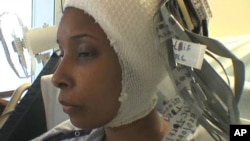Researchers say a study on the brain is shedding light on how humans process language. The research, conducted in San Diego, Boston and New York, is helping scientists understand an important part of the brain known as Broca's area.
Denise Harris, 39, is helping with the study. She suffers from epilepsy, and doctors at the medical center of New York University are monitoring her seizures in the hope of performing an operation to minimize them.
"I've been on many medications throughout my life and after a while, they don't work," she noted. "I still get seizures. So now, when they remove the part that the seizure is triggered from, it's supposed to stop."
While Harris is in hospital, she is helping scientists understand how the brain comprehends and uses language.
The results of the work, based on brain studies of Denise and other patients, were published in the journal Science.
Using the process called Intra-cranial Electrophysiology, clinical tests in Boston and New York found that one small part of the brain, known as Broca's area, computes three different language functions, all within a quarter of a second. The first deals with recognizing a word, the second with understanding the word's context in a sentence, and the third lets us articulate the word through speech.
One of the study's author, Eric Halgren of the University of California, San Diego, School of Medicine, says this part of the brain is central to language.
"What we were able to find was that within a centimeter, around less than an inch, certainly, and probably half an inch, there were different regions - perhaps they overlap some - but they were doing, at different times, different processes, all within this small area," said Halgren.
Another study author, Ned Sahin, a post-doctoral fellow at Harvard University and the UC San Diego School of Medicine, says scientists have suspected for some time that the traditional understanding of the brain needs revision.
"Nearly every introductory text book, as well as people practicing in the field in speech pathology, for instance, teaches and believe that there is a separation of tasks and a division of labor between two very different parts of the brain, Broca's area [at the front of the brain] and Wernicke's area [further back in the brain], where Broca's area is responsible for producing, for speaking, and Wernicke's for comprehending," explained Sahin.
This study shows that Broca's area does more than scientists had realized. Sahin says researchers increasingly realize that individual parts of the brain have multiple functions.
"… because here's an example of one relatively small part of the brain that's doing three very different things at three different times, but all within the space of a quarter of a second," he added.
Eric Halgren says, despite our growing knowledge, much about the brain remains unknown.
"How does this hunk of flesh, which is not much different from a muscle - it's just a bowl of porridge - how does it produce the mind? It's a total mystery," noted Halgren.
He says brain studies are shedding light on the pieces of the puzzle, and may one day solve the mystery.









